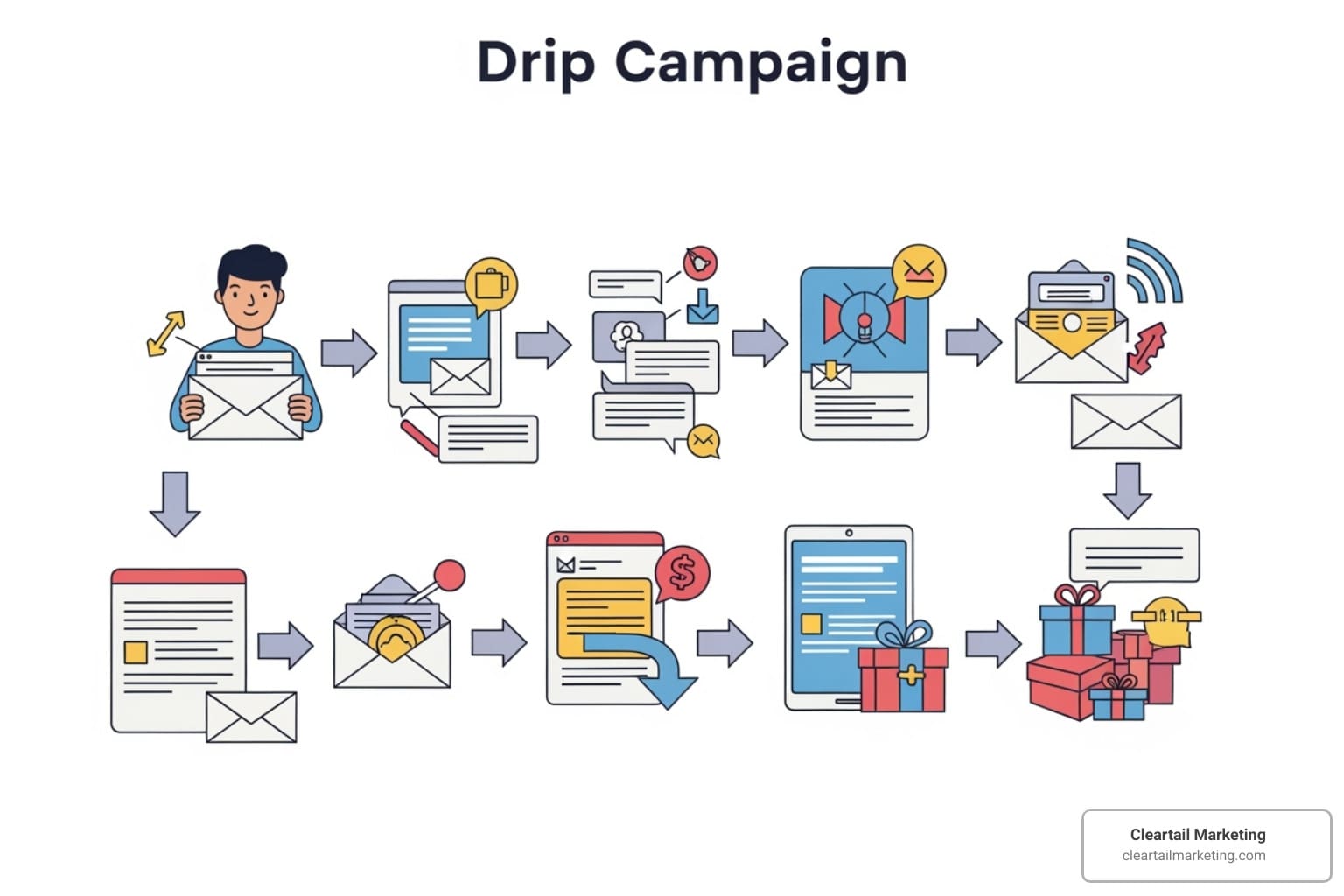Why Drip Campaign Best Practices Are Essential for Business Growth
Drip campaign best practices can transform your email marketing from a scattered effort into a revenue-generating machine. Research shows that drip emails generate a 119% increase in click rate compared to standard promotional emails, while automated campaigns perform two times better than one-off email blasts.
The Essential Drip Campaign Best Practices:
- Segment your audience – Target specific groups based on behavior and demographics
- Personalize your content – Use dynamic content and personalization tokens
- Map content to the customer journey – Align emails with awareness, consideration, and decision stages
- Optimize timing and frequency – Test spacing between emails (typically 4-10 emails, 4 days to 2 weeks apart)
- Create compelling CTAs – Include one clear call-to-action per email
- Test and measure – Track open rates, click-through rates, and conversion rates
- Ensure mobile optimization – 81% of emails are opened on mobile devices
- Maintain compliance – Include unsubscribe options and follow CAN-SPAM guidelines
The numbers speak for themselves: companies using drip campaigns generate 80% more sales leads on average, and automated emails drive about 75% of all email marketing revenue. With 87% of marketers planning to increase their email marketing investment, implementing these best practices isn’t just smart – it’s essential for staying competitive.
Why most businesses struggle with drip campaigns:
- Lack of proper segmentation (42% of marketers don’t segment at all)
- Poor timing and frequency decisions
- Generic, non-personalized content
- Missing mobile optimization
- Inadequate testing and optimization
I’m Magee Clegg, founder and CEO of Cleartail Marketing, and over the past decade I’ve helped 90+ B2B companies implement successful drip campaign best practices that have generated millions in revenue and dramatically improved customer acquisition rates. My experience includes increasing client revenues by 278% in 12 months and delivering 5,000% ROI through strategic email automation campaigns.
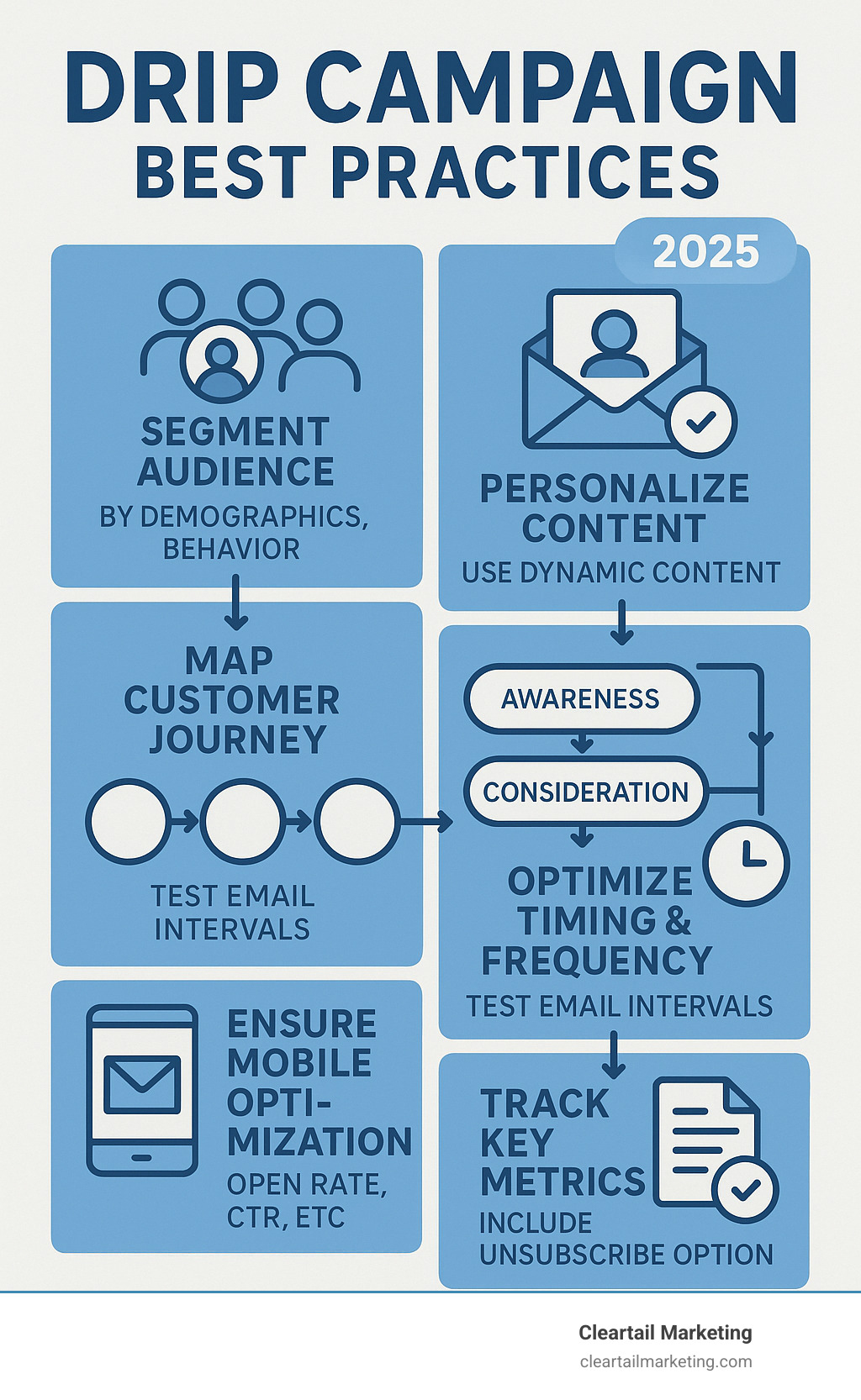
Relevant articles related to drip campaign best practices:
What Are Email Drip Campaigns and Why Do They Matter?
Imagine swapping the megaphone of a one-off email blast for a private conversation that starts the instant a prospect raises their hand. That is the power of an email drip campaign—an automated series of emails released when a subscriber’s behaviour or a pre-set schedule says “now.” Build the workflow once and it runs on autopilot, turning every download, cart abandonment, or period of inactivity into a timely touch-point.
How Drips Work
- Automated sequence – you create it once.
- Behavioural triggers – downloads, visits, purchases, inactivity.
- Personalised content – each message references the subscriber’s context.
- Strategic timing – the interval matches the buyer journey.
Because every send is relevant, drip emails generate a 119% higher click rate than standard promotional blasts.
The Core Benefits of a Well-Executed Drip Strategy
- Higher conversion rates – relevance drives action.
- Effortless lead nurturing – eight-plus touch points happen automatically.
- Greater customer lifetime value – continued value builds loyalty.
- Scalability – 50 or 50,000 contacts receive the same white-glove experience.
- Time savings – your team designs once and focuses on strategy, not sending.
Drip Campaigns vs. Standard Email Blasts
| Drip Campaigns | Email Blasts | |
|---|---|---|
| Sending method | Automated | Manual |
| Trigger | Behaviour / Schedule | Marketer’s decision |
| Personalisation | High (segment & dynamic content) | Low |
| Structure | Series that tells a story | One-off |
| Audience size | Specific segment | Entire list |
Email blasts still have a place for urgent news, but for relationship-building and predictable revenue, well-designed drips win every time.
Strategically Planning Your Drip Campaign Around the Customer Journey
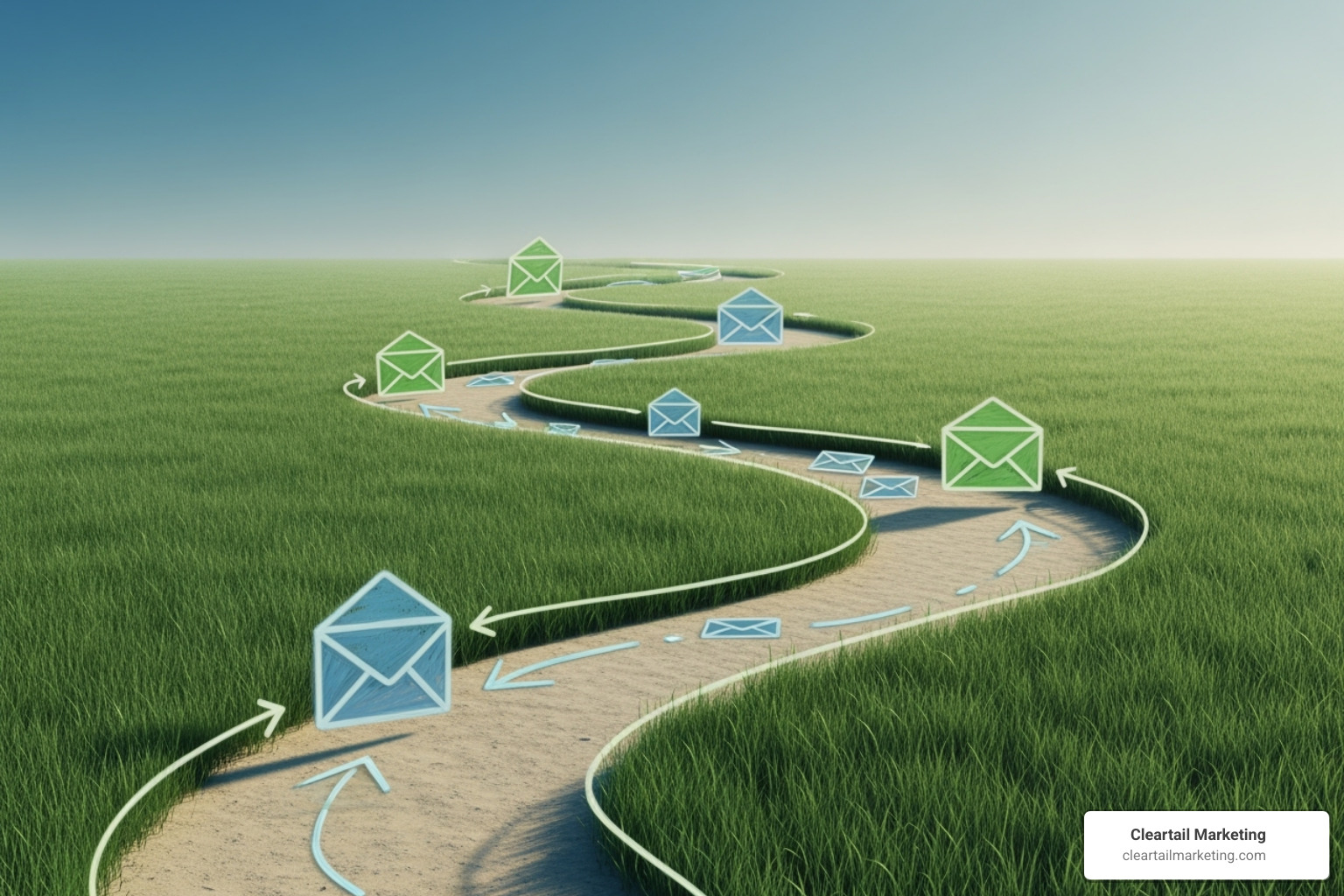
Launching emails without a map is like proposing on the first date—awkward and usually unsuccessful. The smartest drip campaign best practices mirror the five classic stages of the buying journey:
- Awareness – prospects find a problem.
- Consideration – they research solutions.
- Decision – they compare vendors.
- Retention – they learn to use the purchase.
- Loyalty – they become repeat buyers.
Match every email to the question a prospect is asking at that moment and you will instantly feel more relevant.
Step 1: Define Goals & Segments
Set a measurable finish line such as “increase trial-to-paid conversions by 25 %.” Then build segments around behaviour, purchase history, firmographics, or lifecycle stage. A recent survey found that targeted emails double click-through rates—proof segmentation is worth the effort.
Step 2: Map Content to the Funnel
- Awareness: blog posts, checklists, industry reports.
- Consideration: case studies, webinars, ROI calculators.
- Decision: demos, pricing sheets, testimonials.
- Retention/Loyalty: onboarding tips, upgrade offers, referral requests.
An 80/20 mix (value first, promotion second) keeps trust high while nudging prospects forward.
Step 3: Establish Triggers & Logic
Use actions such as form fills, page views, purchase events, or inactivity to start—or branch—a sequence. If a user downloads pricing but doesn’t book a demo within seven days, automatically send a success story. Modern platforms make these “if/then” paths simple and they work 24 / 7.
The Ultimate Drip Campaign Best Practices for Maximum Impact

Automation is only half the equation—the other half is creating emails people genuinely want to read. Focus on these three areas.
Crafting Compelling, Personalized Content
True personalization means understanding where a subscriber is in their journey, not just adding their first name. Keep subject lines under 50 characters, pair them with complementary pre-header text, and stick to one clear CTA per email. Follow the 80/20 rule (value versus promotion) and format for quick scanning. According to Statista, 60 % of shoppers abandon brands that ignore personalization—don’t give them a reason.
Finding the Right Cadence
- Welcome series: 3–5 emails in the first week.
- Abandoned cart: 2–3 emails within 72 hours.
- Lead nurture: 4–10 emails over 2–8 weeks.
Begin conservatively, then A/B-test tighter spacing. Rising unsubscribe or falling engagement rates signal you’re emailing too often.
Technical & Compliance Must-Haves
- Mobile-first, single-column design with 44 px buttons.
- Fast-loading images with descriptive alt text.
- Rigorous list hygiene and authentication (SPF, DKIM, DMARC).
- Clear unsubscribe link and CAN-SPAM compliance.
Nail these basics and every creative improvement you make will have room to shine.
Common Types of Drip Campaigns (With Examples)
Different objectives call for different sequences. Below are the four we build most often for Cleartail Marketing clients.
Welcome & Onboarding
Goal: greet new contacts and set expectations. Welcome emails deliver a 14.34 % click-through rate—seven times the average. Send the first message immediately, provide an instant win (resource or discount) and point to next steps.
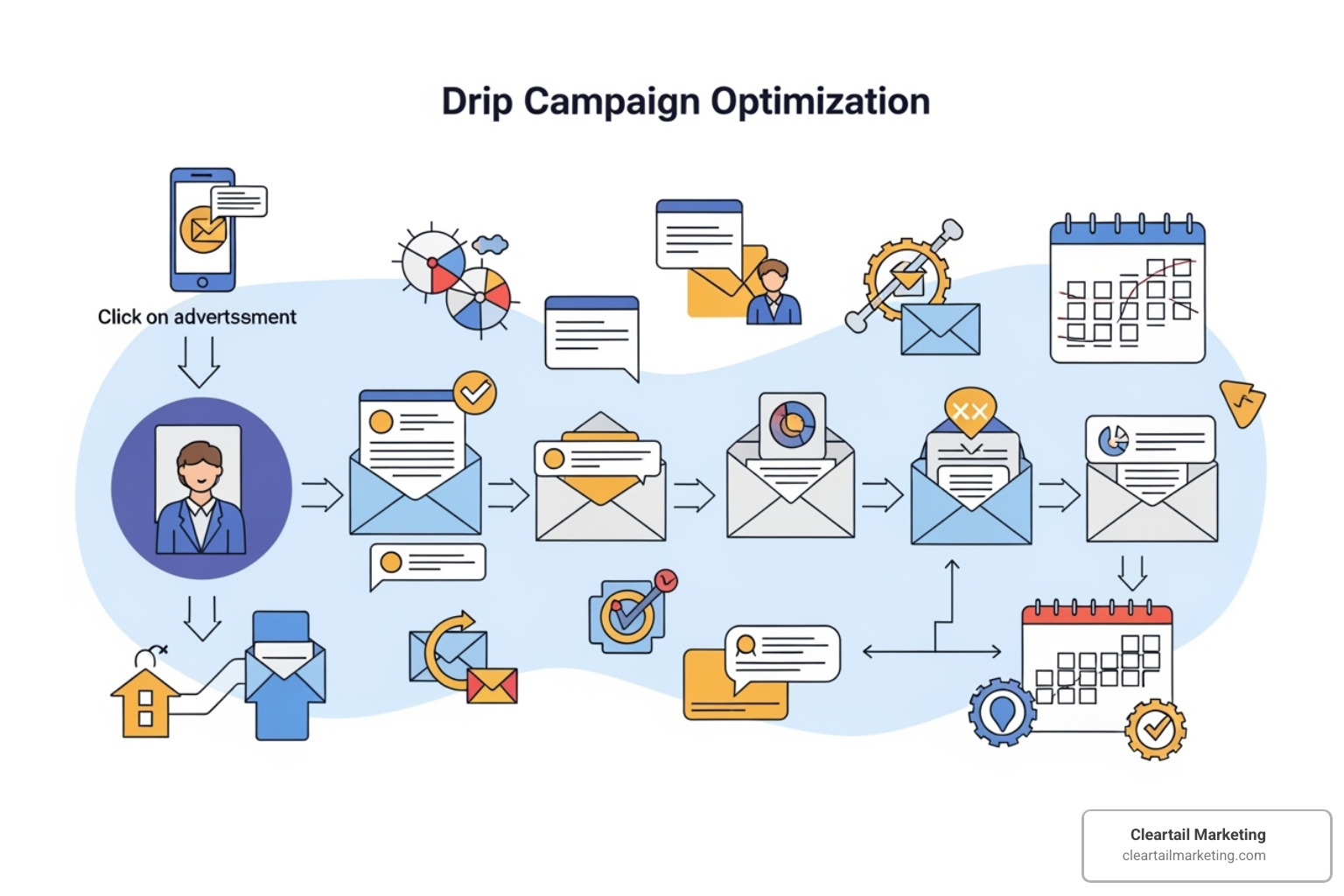
Typical flow:
- Instant welcome/value
- Your story
- Best resources
- Social proof
- Invitation to engage
Abandoned Cart
With 70 % of shoppers leaving items behind, this campaign is a revenue lifesaver. Send a friendly reminder within three hours, follow up the next day to answer objections, and (optionally) close with a limited-time incentive. Brands recover up to 33.9 % of lost orders using this approach.
Lead Nurturing
Ideal for longer B2B cycles. Share educational content first, then case studies, and finally a soft pitch (demo or consultation). It often takes eight touches to convert—automation ensures you deliver them consistently.
Re-engagement / Win-Back
When subscribers go quiet, acknowledge the gap, remind them of your value and offer a reason to return.

Three emails are plenty: “We miss you,” an incentive, and a last-chance preference-centre message. Remove the contact if they stay inactive to protect deliverability.
Measuring Success and Optimizing Your Campaigns
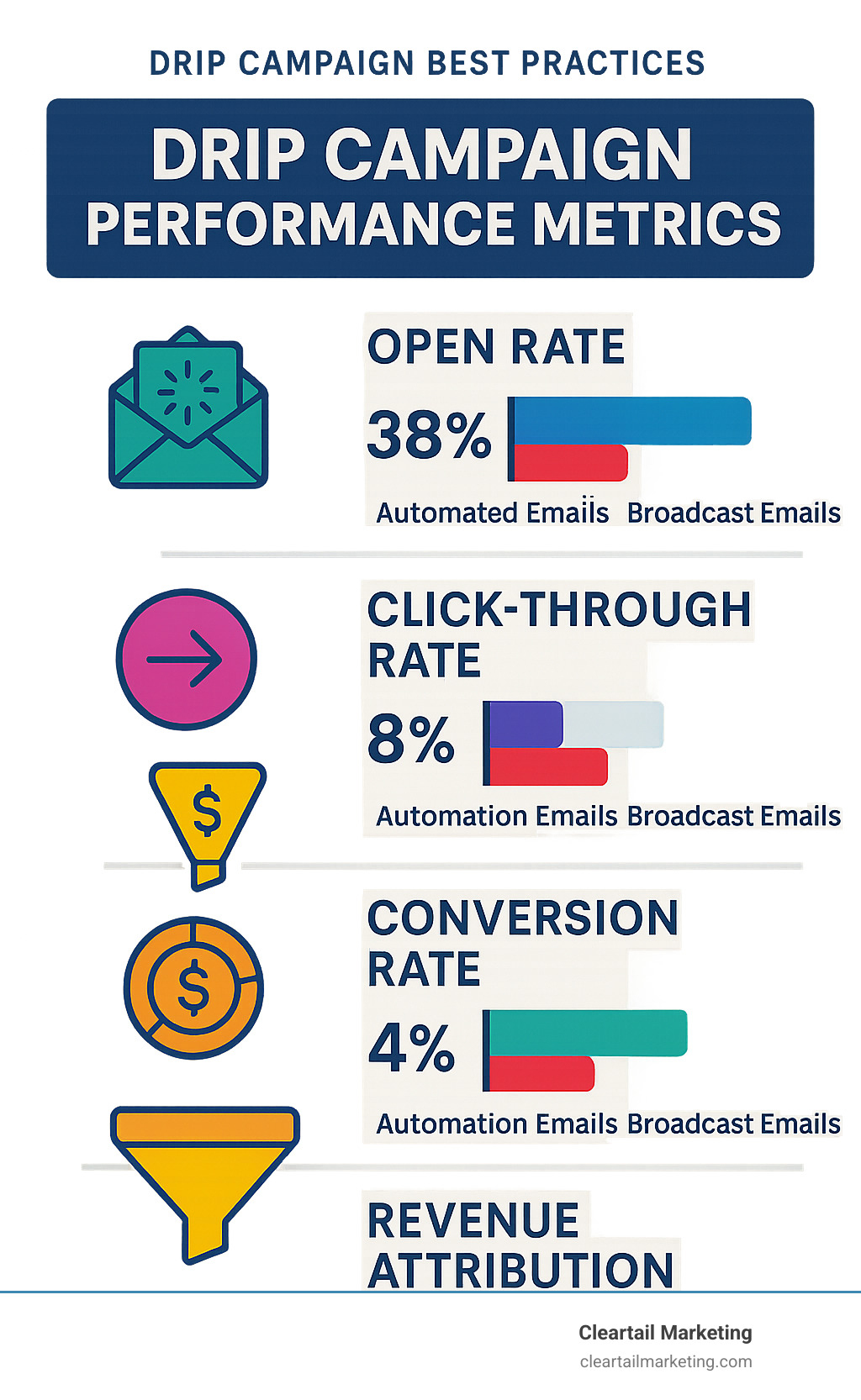
If you are not measuring, you are guessing. Track these metrics for every sequence:
- Open rate – early indicator of subject-line health.
- Click-through rate – shows message relevance.
- Conversion rate – ties emails to pipeline or revenue.
- Revenue per email – our favourite “board-level” KPI.
- Unsubscribe & spam rates – guardrails that alert you to over-mailing.
Look at performance across the entire series because conversions often peak after trust is built (typically emails 3–5).
Choosing the Right Platform
The platform should support visual workflow building, robust segmentation, A/B testing, and CRM integration. We frequently recommend:
- HubSpot – all-in-one marketing + sales.
- Mailchimp – simple and affordable for smaller lists.
- ActiveCampaign – advanced automation at a mid-market price.
- Pardot – best choice for Salesforce shops.
Whichever tool you choose, pair it with data-driven iteration and your drip campaigns will keep improving month after month.
Frequently Asked Questions about Drip Campaigns
I get these questions all the time from clients who are just starting to explore drip campaign best practices. Let me clear up some common confusion and share what we’ve learned from implementing hundreds of campaigns.
What’s the difference between a drip campaign and a nurture campaign?
This is probably the most common question I hear, and honestly, the terms get thrown around pretty loosely in the marketing world. Here’s the simple breakdown:
Drip campaigns are the umbrella term for any automated email sequence. Think of them as the delivery mechanism – they’re like a sprinkler system that waters your garden on a schedule or when certain conditions are met.
Nurture campaigns are a specific type of drip campaign with a particular goal: building relationships and educating leads over time. They’re typically longer, more complex, and focused on guiding someone through a learning journey rather than just delivering information.
Here’s a practical example: A three-email welcome series is a drip campaign, but it’s not really nurturing – it’s more about orientation and immediate value delivery. On the other hand, a 10-email sequence that educates prospects about industry trends, shares case studies, and gradually introduces your solution? That’s definitely a nurture campaign.
The key difference is intent and complexity. All nurture campaigns are drips, but not all drips are designed for nurturing. Some are just about getting stuff done efficiently.
How many emails should be in a drip campaign?
I wish I could give you a magic number, but the truth is it depends on what you’re trying to accomplish. That said, we’ve tested this extensively and found some useful patterns.
Most campaigns fall between 4 to 10 emails, and there’s good reason for this range. Our data shows that engagement typically peaks around emails 3-5, then gradually declines. This means you want to front-load your most important messages.
Here’s what we typically recommend based on campaign type:
Welcome series: 3-5 emails over one week. People are excited when they first sign up, so strike while the iron is hot.
Abandoned cart recovery: 2-3 emails over three days. You’re dealing with immediate purchase intent, so act quickly.
Lead nurturing: 4-10 emails over 2-8 weeks. These need more runway because you’re building relationships and trust.
Re-engagement campaigns: 2-3 emails over one week. If someone hasn’t been engaging, don’t drag it out.
The best approach? Start with fewer emails and test adding more. It’s easier to expand a successful short sequence than to fix a long one that’s annoying people. Always let your unsubscribe rates and engagement metrics guide your decisions.
Can I use drip campaigns for B2B marketing?
Absolutely, and I’d argue they’re even more effective for B2B than B2C in many cases. Here’s why:
B2B buyers expect educational content. They’re not making impulse purchases – they’re researching, comparing options, and building business cases. Drip campaign best practices for B2B focus on being genuinely helpful throughout this process.
The longer sales cycles in B2B actually work in your favor with drip campaigns. While a consumer might buy a product after seeing one ad, a B2B buyer might need months of nurturing. Drip campaigns keep you top-of-mind without being pushy.
We’ve seen B2B drip campaigns consistently outperform B2C campaigns in terms of engagement and conversion rates. Business buyers appreciate receiving valuable insights, industry reports, and case studies that help them do their jobs better.
The key is positioning yourself as a trusted advisor rather than just another vendor. Share industry insights, address common challenges, and demonstrate your expertise through helpful content. When they’re ready to buy, guess who they’ll think of first?
More info about B2B Drip Campaigns covers this topic in much more detail, including specific examples and templates we’ve used successfully.
One thing that’s different about B2B drip campaigns is the need for sales alignment. Your marketing automation needs to work seamlessly with your sales process, so the handoff feels natural when a lead is ready to talk to a human. This integration is crucial for maximizing the ROI of your drip campaigns.
Conclusion
Implementing effective drip campaign best practices isn’t just about sending automated emails – it’s about creating meaningful conversations that happen at exactly the right moment. Think of it as being the helpful friend who always knows what to say and when to say it.
The journey we’ve taken together through this guide shows that successful drip campaigns are built on a foundation of strategic planning around the customer journey. When you take time to understand where your prospects are and what they need, you can create experiences that feel personal and valuable rather than pushy or generic.
Personalization remains the game-changer here. We’re not talking about just dropping someone’s name into an email – we mean delivering content that actually matters to them based on their behavior, interests, and stage in the buying process. When 60% of shoppers abandon brands that don’t personalize their experience, this isn’t optional anymore.
Getting the timing and frequency right can make or break your campaigns. Too many emails and you become annoying. Too few and you lose momentum. The sweet spot usually falls between 4-10 emails spaced thoughtfully based on your audience’s preferences and your testing results.
With 81% of emails opened on mobile devices, mobile optimization isn’t just nice to have – it’s essential. Your beautifully crafted email means nothing if it looks terrible on a phone screen or takes forever to load.
Perhaps most importantly, continuous measurement and optimization separates the campaigns that work from those that don’t. The data tells you what’s working, what isn’t, and where your biggest opportunities lie. Without this feedback loop, you’re just guessing.
Don’t forget the technical side either. Compliance and deliverability might not be exciting, but they’re what keep your emails out of spam folders and your business out of legal trouble.
Here’s what makes this all worthwhile: drip campaigns are genuinely powerful tools for building relationships and driving revenue. Companies using these strategies generate 80% more sales leads on average, and automated emails drive about 75% of all email marketing revenue.
At Cleartail Marketing, we’ve watched these drip campaign best practices transform businesses. We’ve helped clients achieve 278% revenue increases and 5,000% ROI improvements by treating drip campaigns as strategic marketing systems rather than just another email tactic.
The beauty of drip campaigns is that they work while you sleep. Once you’ve built them correctly, they’re nurturing leads, answering questions, and moving prospects toward purchase decisions 24/7. It’s like having your best salesperson working around the clock, but without the coffee breaks.
By following these best practices and staying committed to testing and optimization, you can build email marketing that actually converts. Your campaigns will become that helpful friend your prospects look forward to hearing from – and that’s when the magic happens.
Ready to put these strategies to work? Master your marketing with our guide to the best practices for drip campaigns or reach out to discuss how we can help you build drip campaigns that deliver real, measurable results for your business.


